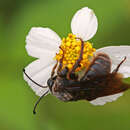en
names in breadcrumbs


The nesting biology of this bee is described by Wcislo and Engel (1996). From Wcislo and Engel (1996) Appendeces 1 and 2: Nests in Soil. Turret or nest chimney is present. Maximum depth of nest in soil is up to 100 cm. The orientation of the main axis of the nest cell is vertical. The cell shape is radially symmetric. A cell lining is present. Cells are arranged in the nest evenly spaced along lateral tunnels. Cells are not attached to the main tunnel with lateral tunnels. The interior face of the nest plug has a spiral. The shape of the pollen mass inside the cell is ovoid saucer-shaped. The pollen mass is oriented snugly in the bottom of the cell. The pollen mass is not coated with a secretion. The shape of the pupal fecal deposit is cylindrical, sausage-shaped. The location of the pupal fecal deposit is restricted to the basal quarter of the cell. The orientation of the main tunnel in the soil is vertical. The main tunnel has horizontal branches. Pollen use is restricted to one plant family. The nest entrance is plugged when female(s) leave the nest. cells are not re-used. Nests are dug into horizontal ground. Social behavior, from Wcislo and Engel (1996) Table 1: Solitary, based on 9 nests from Notom UT, and 15 nests from West Turkey Creek AZ, USA.